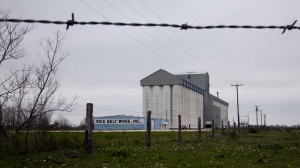How New Texas Water Supplies Could Help Both Farmers and Cities

Photo by Jeff Heimsath/StateImpact Texas
Many rice mills and drying and storage facilities in Southeast Texas didn't see much work last year. If they're cut off again this year, the slow business will continue.
For the rice farmers of Southeast Texas, 2012 was a rough year. For the first time in history, they were cut off from water because there wasn’t enough in the main reservoirs of the Lower Colorado River to supply them. In 2013, they face the same situation: if there isn’t enough water in the Highland Lakes come March 1, they won’t get water again this year. The quasi-public agency making the call is the Lower Colorado River Authority (LCRA). But there’s some good news for rice farmers coming from the LCRA as well. Today the Agency approved the first phase of a new plan that will help both rice farmers and municipal interests in the years to come.
Ronald Gertson is a fourth-generation rice farmer in Wharton County. The industry is over a hundred years old, and was damaged by the cutoff last year. While crop insurance covered up to 85 percent of the losses for the farmers, and will do the same this year if they go without water again, Gertson says that they’ve been told they will not get crop insurance if they are cut off again next year. “A third year would definitely put some folks permanently out of rice farming,” he says.
And the ancillary businesses without crop insurance that rely on the South Texas rice industry, like grain storage and processing, have suffered. “There were about 53,000 acres that didn’t get planted in 2012 that normally would have been,” Gertson says.
Enter the idea of “off-channel” reservoirs, smaller sources of storage downstream, below the Highland Lakes and the City of Austin. During wet times, as the Lower Colorado River sees good flows, water will be diverted and held for later use, alleviating the strain on the Highland Lakes.
The problem, as Gertson and others see it, is that the Highland Lakes have more strain on them than ever before, while inflows are at extreme lows. More people (and, not coincidentally, more lawns) means more municipal demand, primarily from the City of Austin, which pays a premium for guaranteed water. Then there are the agricultural demands from rice farmers on the reservoirs, which are in fact much greater, while the farmers pay significantly less for water. In 2011, the period of the worst one-year drought in recorded Texas history, the LCRA sent a massive amount of water to rice farmers downstream, and the Highland Lakes have yet to recover. They currently sit at only 42 percent full.
The Lower Basin Reservoir Project that had its first phase approved unanimously by the board today is a $206 million, four-year plan to purchase land and develop a smaller reservoir downstream in Wharton County, the lakes will suffer less. According to the LCRA, it “has the potential to produce approximately 90,000 acre-feet of firm yield per year.” Combined with a groundwater supply project in Bastrop, projected to cost $15 million, the LCRA will achieve its goal of developing 100,000 acre-feet of new water supplies downstream of the Highland Lakes. That’s roughly a third of what rice farmers used from the lakes in 2011, and equal to the water that the City of Austin used from the lakes that year.
“Had they [the lower reservoirs] been in place in 2011, we would have ended that year with considerably more water in the Highland Lakes,” says Gertson, adding that it would have really helped last year when they were cut off.
“The water could be used by both agriculture and firm customers such as industry and power plants, but it would provide a benefit to everyone in the basin because it would lower the demands on water from the Highland Lakes,” LCRA spokesperson Clara Tuma says.
“It makes some sense,” says Andrew Sansom, a conservationist and water expert with the Meadows Center for Water and the Environment. “We’ve had downstream reservoirs on the lower Brazos River since World War II, and it’s served that part of the state very well.” He adds that downstream reservoirs have the added benefit of having less environmental impact than larger upstream reservoirs, “where you have a lot of sensitive habitat that would be destroyed or inundated.”
“The sad thing is, that we’re in a time when it seems like there’s only winners and losers with water in Texas,” Sansom points out. “The big dogs eat first. So a downstream reservoir would be a way of ameliorating that.”
The first $18 million needed to purchase the land, undergo permitting, and do preliminary engineering, according to the LCRA. That cash will come from “existing revenue from all LCRA water customers,” Tuma says. Water rates for LCRA customers could go up as a result. “Staff has committed to managing development costs of these water supplies to minimize, if not completely avoid, any need for a rate increase,” Tuma says.
Money for the rest of the project will likely come from grant, loans and outside funding, according to the LCRA.
“We are cautiously optimistic,” rice farmer Gertson says.

